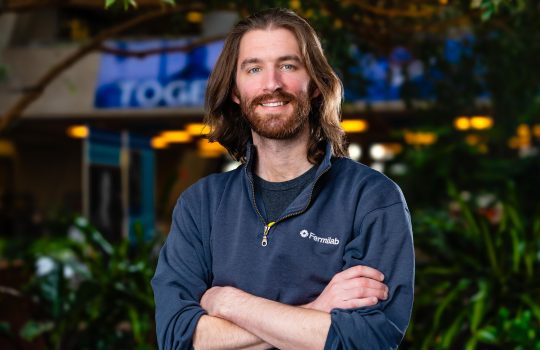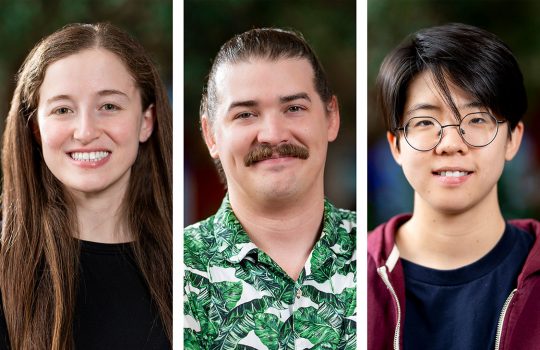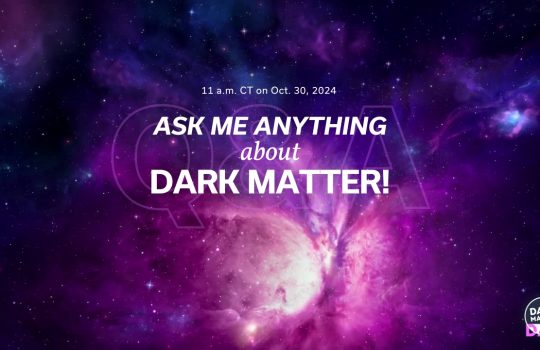After riding in a cage with nickel miners, walking down drifts and stopping at the dry, SuperCDMS scientists enter their shotcrete igloo of discovery deep underground.
Translating this out of mining lingo: After taking an elevator down a two-kilometer mineshaft with nickel miners, Fermilab scientists walk through nearly two more kilometers of tunnels and then shower and change before entering the white-walled cavern that will house the Super Cryogenic Dark Matter Search, an experiment that will look for dark matter particles with masses ranging from half to 10 times the mass of a proton.
Dark matter, thought to make up approximately 85% of matter in the universe, emits no light and interacts rarely with normal matter. These characteristics make it difficult to detect, and only through very sensitive experiments such as SuperCDMS might it be possible to directly observe.
This summer, Fermilab scientists Matt Hollister and Dan Bauer will make this journey themselves to install the new SuperCDMS dilution refrigerator at SNOLAB near Sudbury, Ontario, Canada.
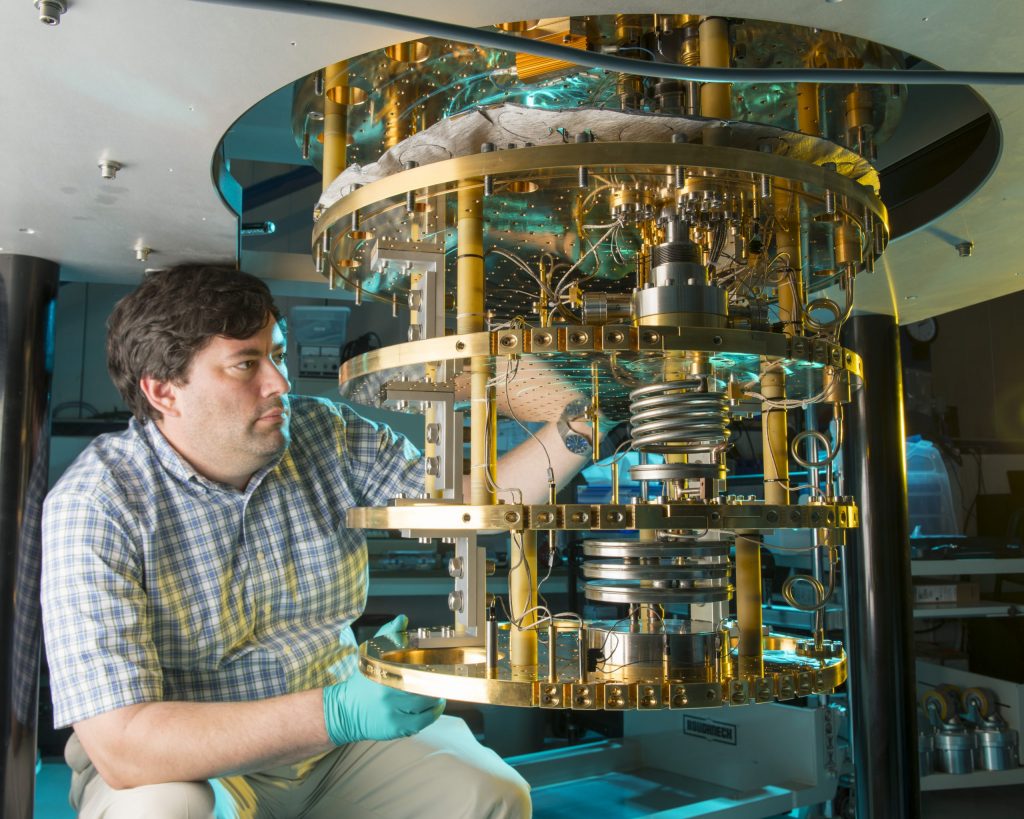
Fermilab scientist Matt Hollister works on the world’s largest dry dilution fridge, which will be used for the SuperCDMS experiment at SNOLAB. Image: Reidar Hahn, Fermilab
The coldest place at Fermilab
This development is made possible by a milestone reached in late October: SuperCDMS scientists cooled their dilution refrigerator, often just called a fridge, down to 5.3 millikelvin, only a few thousandths of a kelvin above absolute zero.
“The temperature we reached is the lowest ever achieved at Fermilab and is one of the lowest ever achieved with a modern, commercially built fridge,” said Matt Hollister, the main designer for the SuperCDMS cryogenic system.
To put this temperature into perspective, the coldest air ever recorded on Earth was 184 kelvins (around minus 89.2 degrees Celsius), logged at the Soviet Vostok Station in Antarctica in 1983. Outer space has a temperature of 2.7 kelvins (minus 270 degrees Celsius).
Extreme cold isn’t new for SuperCDMS scientists, who have run their experiments at successively lower temperatures over the past few decades to achieve new levels of sensitivity and precision in their data. SuperCDMS SNOLAB will be approximately 50 times more sensitive to low-mass dark matter particles than its previous iteration, which took data 700 meters underground at Soudan Underground Laboratory in northern Minnesota.
“SuperCDMS SNOLAB should be able to see the vibrations, or phonons, caused by a single dark matter particle bouncing off a nucleus or the electrons in the detector,” said Bauer, lead SuperCDMS scientist at Fermilab.
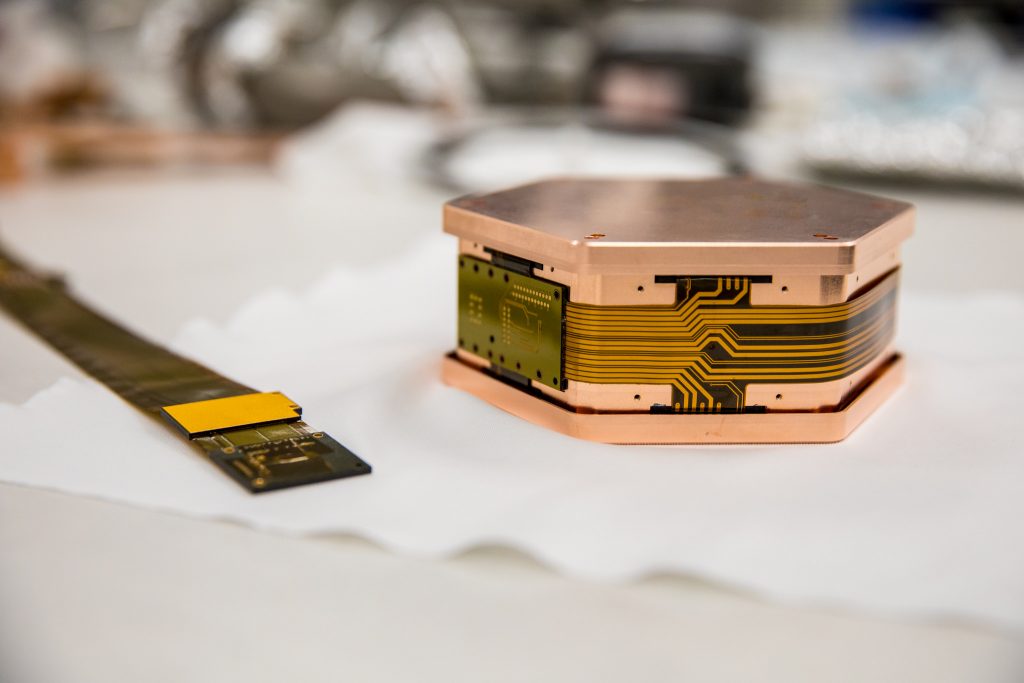
SuperCDMS SNOLAB detectors are made of germanium and silicon and will be approximately 50 times more sensitive to dark matter particles than the experiment’s previous iteration, SuperCDMS Soudan. Photo: Andy Freeberg, SLAC National Accelerator Laboratory
Temperatures that hover just above absolute zero are critical if SuperCDMS is to detect dark matter. The colder the crystals in the dark matter detectors, the easier it will be to spot vibrations caused by dark matter particles. It’s kind of like stepping outside during a Chicago winter with only a lightweight jacket. Just as people are more likely to notice you shivering if it’s 20 below rather than above freezing, so too are dark matter detectors more likely to spot a dark matter particle at lower temperatures.
Before they could begin searching for dark matter particles, though, the scientists needed a fridge.
Dilution fridges 101
The SuperCDMS SNOLAB dilution fridge arrived at Fermilab earlier this year from Leiden Cryogenics, a company based in the Netherlands. With twisting gold and copper tubes of various shapes and sizes adorning successively smaller platforms, the fridge looks like a tiered chandelier that delicately balances two fluids – helium-3 and helium-4.
Helium-3 and helium-4 are isotopes of helium that behave not unlike oil and water. At high temperatures, they stay mixed, but as the temperature is lowered, they separate. In SuperCDMS, helium-3 pumped into the fridge encounters helium-4 sitting at the bottom of the fridge. In a spontaneous quantum mechanical phase change, helium-3 “evaporates” into the helium-4 by pulling heat from a nearby energy source: the fridge itself. This phase change cools the fridge and its detectors when the helium-3 gets pumped out of the fridge.
The SuperCDMS fridge does not need expensive liquid cryogens and does not require nearly as much maintenance as older dilution refrigerators. As an added bonus, the adjacent gas exchange system that helps dissipate heat stored in the helium-3 also removes impurities, making the cooling process more efficient and sustainable long-term.
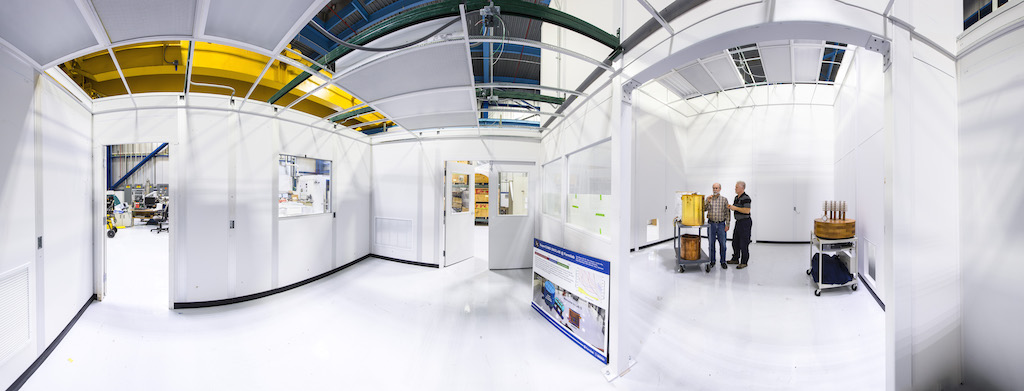
This panoramic view shows the Fermilab cleanroom for the SuperCDMS experiment. Pictured are lead SuperCDMS scientist Dan Bauer and senior technical specialist Mark Ruschman. Photo: Reidar Hahn, Fermilab
A fridge unlike any other
The fridge for SuperCDMS in its previous iteration at Soudan in Minnesota never dipped below 12 millikelvin. Getting colder for SuperCDMS SNOLAB required overcoming significant challenges. In fact, designing a system that would even work at such low temperatures for long periods of time was difficult.
To lower the backgrounds seen by its detectors, SuperCDMS scientists decided to house them several meters away from the fridge itself and link them thermally.
This decision led to some thought-provoking questions. Namely, how do you transfer heat away from the detectors in subkelvin temperatures when the fridge and the detectors are so far apart?
“Because there are so few people doing this kind of work, we couldn’t turn to the literature to see how a particular material will perform,” Hollister said.
Fermilab scientists spent several years designing and testing components such as a copper cryostat and thermal joints that would thermally connect the fridge and the detectors, making advances in materials science along the way.
“Hopefully others will find our work useful as well,” Hollister said.
There are also practical concerns for day-to-day operations, like the fact that SNOLAB is located in an active nickel mine. Because science is folded into the mining schedule, the scientists typically go down to SNOLAB – and return to the surface – at prearranged times. One consequence of this regimented schedule is that scientists and SNOLAB must coordinate well in advance what work needs to be done and when.
“You don’t have the access that you would if you were doing an experiment at Fermilab,” Bauer said. “You have to do a lot more planning to make sure your experiment is robust. You have to make sure that nothing will happen if the power goes off, for example, because you just can’t get down there all the time.”
From Fermilab to SNOLAB
With the fridge up and running at Fermilab, scientists must now plan the trip north to its new home near Sudbury, Ontario, in Canada.
After running checks to make sure that heat flows out of the fridge efficiently, scientists will disassemble the fridge at Fermilab and reassemble it at SNOLAB. Then, they’ll run it underground for several months next summer to check that the move didn’t affect its performance. Finally, they will integrate it with the rest of the experiment, which receives contributions from three DOE national laboratories as well as universities and partner institutions in the United States, Canada, France, the United Kingdom and India.
That’s when the scientists will start collecting data.
“Everybody really wants to get SuperCDMS SNOLAB operating,” Bauer said. “It’s going to be fun. Now that all the changes we’ve made to improve upon SuperCDMS Soudan are being realized, we’re all eager to get back in the game to find dark matter.”
Fermilab is a DOE national laboratory supported by the Office of Science. Construction of SuperCDMS SNOLAB is managed by DOE’s SLAC National Accelerator Laboratory for the international SuperCDMS collaboration. SuperCDMS also receives funding from the National Science Foundation, Canada Foundation for Innovation and SNOLAB.

